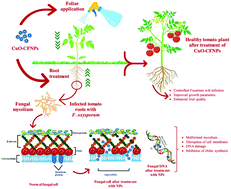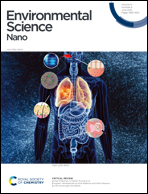Inhibition mechanism of green-synthesized copper oxide nanoparticles from Cassia fistula towards Fusarium oxysporum by boosting growth and defense response in tomatoes†
Abstract
The global food security challenge is that by 2050 a projected 60% increase in food production will be needed compared to today. Therefore, novel approaches that are eco-friendly and sustainable are necessary for both plants and humans. For over a decade, nanomaterials have played a distinct role in the agricultural sector. They have the potential to minimize chemical usage. The aim of the current investigation was to produce a sustainable source of copper oxide nanoparticles (CuO-CFNPs) by utilizing the leaf extract of Cassia fistula and to explore its fungicidal activity against Fusarium oxysporum f. sp. lycopersici, the causal agent of Fusarium wilt of tomato, under laboratory and greenhouse conditions. The biosynthesized copper oxide-Cassia fistula nanoparticles (CuO-CFNPs) were characterized by UV-vis, FTIR, XRD, DLS, TEM, and SEM with EDX. UV-visible spectra show a broad peak at 320 nm, along with varied reaction conditions. Spherical shaped particles ranging from 12–38 nm were confirmed by XRD, SEM and TEM analysis. In vitro results showed substantial inhibition of hyphal growth and spore germination after exposure to CuO-CFNPs in a dose-dependent manner. Root and foliar application of CuO-CFNPs at different concentrations (5–350 μg mL−1) to infected tomato seedlings significantly reduces the disease and consequently improved the plant growth indexes and fruit quality. At exposure to 300 μg mL−1 of CuO-CFNPs, significant reduction in disease incidence (26.7%) and severity (31.1%) was measured. Treatment with various concentrations of CuO-CFNPs showed an increasing trend in photosynthetic pigments, phenolic content and stress/antioxidant enzymatic compounds. Similarly, accumulation of bioactive compounds such as vitamin C, lycopene and flavonoids in tomato fruit significantly enhances with application of CuO-CFNPs. Moreover, the presence of Cu-content in tomato plants indicates no toxicity towards plant productivity. Inclusively, these outcomes suggest that CuO-CFNPs being a multi-targeting product can be introduced in the agricultural sector for disease management and plant health improvement.

- This article is part of the themed collection: Environmental Science: Nano Recent HOT Articles


 Please wait while we load your content...
Please wait while we load your content...